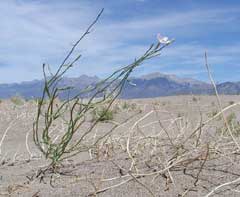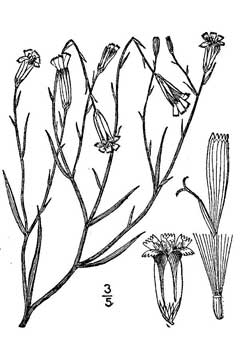 |
|
http://www.nps.gov |
 |
| USDA-NRCS PLANTS Database / Britton, N.L., and A. Brown. 1913. An illustrated flora of the northern United States, Canada and the British Possessions. 3 vols. Charles Scribner's Sons, New York. Vol. 3 |
Translate this page:
Summary
Physical Characteristics

 Lygodesmia juncea is a PERENNIAL growing to 0.3 m (1ft). The species is hermaphrodite (has both male and female organs) and is pollinated by Insects.
Lygodesmia juncea is a PERENNIAL growing to 0.3 m (1ft). The species is hermaphrodite (has both male and female organs) and is pollinated by Insects.
Suitable for: light (sandy) and medium (loamy) soils and prefers well-drained soil. Suitable pH: mildly acid, neutral and basic (mildly alkaline) soils. It cannot grow in the shade. It prefers moist soil.
UK Hardiness Map
US Hardiness Map
Synonyms
Plant Habitats
Cultivated Beds;
Edible Uses
Edible Parts:
Edible Uses: Gum
A gum from the seeds is used for chewing[61, 105]. Other reports say that the gum is obtained from the flowering stems[46, 177]. Another report says that the roots were left in the sun until the gum came out and hardened, and this was then used for chewing[257].
References More on Edible Uses
Medicinal Uses
Plants For A Future can not take any responsibility for any adverse effects from the use of plants. Always seek advice from a professional before using a plant medicinally.
Diuretic Galactogogue Kidney Poultice Tonic
Skeleton weed was employed medicinally by various native North American Indian tribes who used it particularly as a galactogogue[213, 257]. It is little, if at all, used in modern herbalism. The leaves and stems are galactogogue and tonic[213, 257]. An infusion of the stems has been used to promote milk flow in nursing mothers, in the treatment of smallpox, measles, kidney problems, diarrhoea, heartburn and burning coughs and also as a general tonic for children[257]. A poultice of the plant has been applied to bring relief to rheumatic and swollen joints[257]. An infusion has been used as a wash for sore eyes[257]. An infusion of the powdered galls that are found on the plant is diuretic[257].
References More on Medicinal Uses
The Bookshop: Edible Plant Books
Our Latest books on Perennial Plants For Food Forests and Permaculture Gardens in paperback or digital formats.

Edible Tropical Plants
Food Forest Plants for Hotter Conditions: 250+ Plants For Tropical Food Forests & Permaculture Gardens.
More

Edible Temperate Plants
Plants for Your Food Forest: 500 Plants for Temperate Food Forests & Permaculture Gardens.
More

More Books
PFAF have eight books available in paperback and digital formats. Browse the shop for more information.
Shop Now
Other Uses
Gum Hair Insulation
An infusion of the stems, mixed with oil, has been used as a hair tonic[257]. The crushed stems have been used as foot pads in shoes[257].
Special Uses
References More on Other Uses
Cultivation details
We have almost no information on this species and do not know if it will be hardy in Britain, though judging by its native range it should succeed outdoors in most areas of the country. It is likely to require a sunny position in a light well-drained soil.
References Carbon Farming Information and Carbon Sequestration Information
Temperature Converter
Type a value in the Celsius field to convert the value to Fahrenheit:
Fahrenheit:
The PFAF Bookshop
Plants For A Future have a number of books available in paperback and digital form. Book titles include Edible Plants, Edible Perennials, Edible Trees,Edible Shrubs, Woodland Gardening, and Temperate Food Forest Plants. Our new book is Food Forest Plants For Hotter Conditions (Tropical and Sub-Tropical).
Shop Now
Plant Propagation
Seed - sow spring in a cold frame and only just cover the seed. When they are large enough to handle, prick the seedlings out into individual pots and grow them on in the greenhouse for at least their first winter. Plant them out into their permanent positions in late spring or early summer, after the last expected frosts. Division can be tried in the spring.
Other Names
If available other names are mentioned here
Native Range
NORTHERN AMERICA: Canada (Saskatchewan, Alberta, Manitoba, British Columbia), United States (Iowa, Kansas, Minnesota, Missouri, Nebraska, North Dakota, South Dakota, Oklahoma, Colorado, Idaho, Montana, Wyoming, Arkansas, New Mexico, Texas, Arizona, Nevada, Utah)
Weed Potential
Right plant wrong place. We are currently updating this section.
Please note that a plant may be invasive in one area but may not in your area so it's worth checking.
Conservation Status
IUCN Red List of Threatened Plants Status :

Growth: S = slow M = medium F = fast. Soil: L = light (sandy) M = medium H = heavy (clay). pH: A = acid N = neutral B = basic (alkaline). Shade: F = full shade S = semi-shade N = no shade. Moisture: D = dry M = Moist We = wet Wa = water.
Now available:
Food Forest Plants for Mediterranean Conditions
350+ Perennial Plants For Mediterranean and Drier Food Forests and Permaculture Gardens.
[Paperback and eBook]
This is the third in Plants For A Future's series of plant guides for food forests tailored to
specific climate zones. Following volumes on temperate and tropical ecosystems, this book focuses
on species suited to Mediterranean conditions—regions with hot, dry summers and cool, wet winters,
often facing the added challenge of climate change.
Read More
Expert comment
Author
(Pursh.)D.Don.
Botanical References
43235
Links / References
For a list of references used on this page please go here
Readers comment
© 2010, Plants For A Future. Plants For A Future is a charitable company limited by guarantee, registered in England and Wales. Charity No. 1057719, Company No. 3204567.